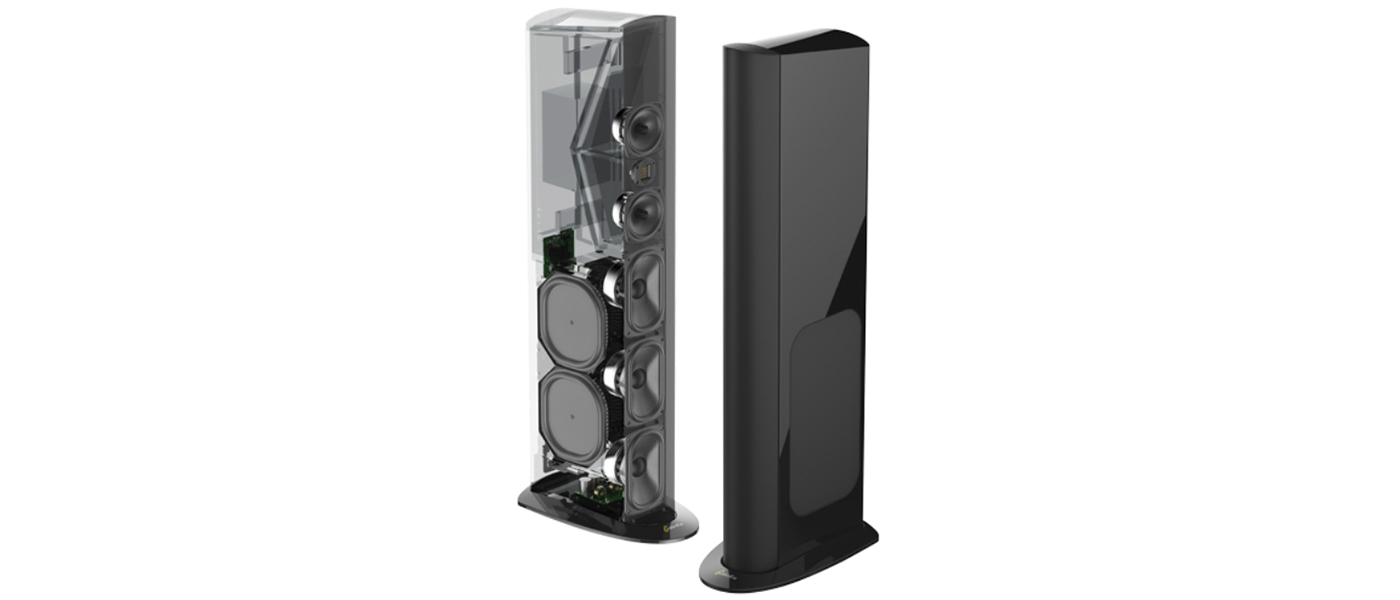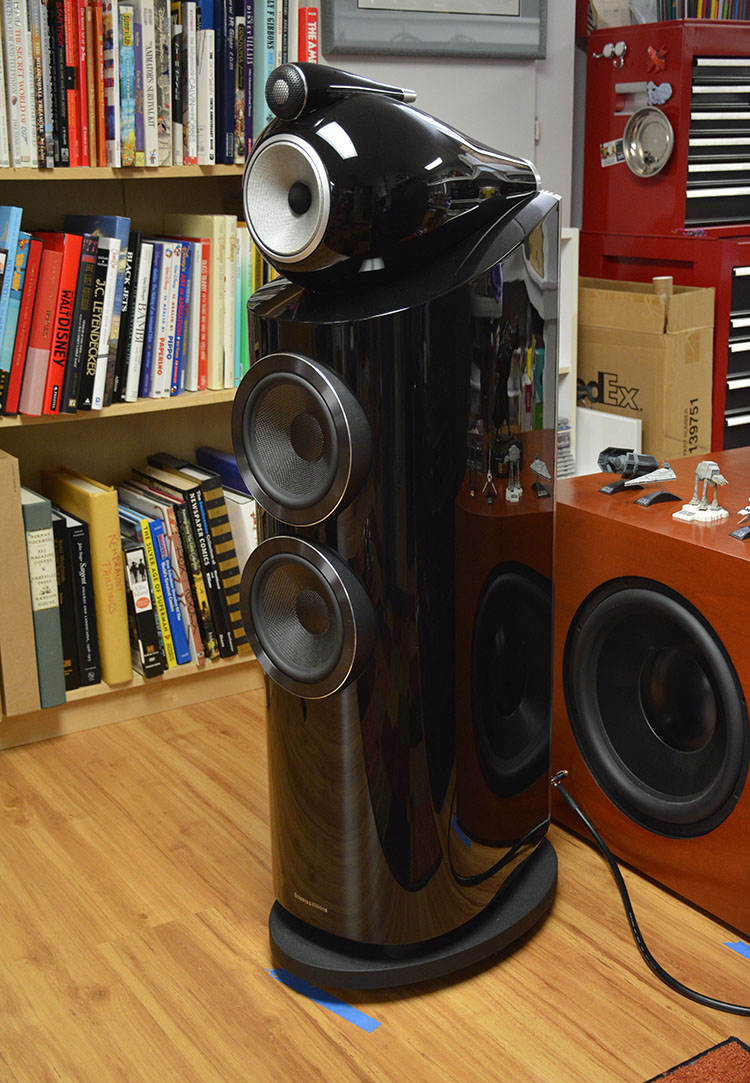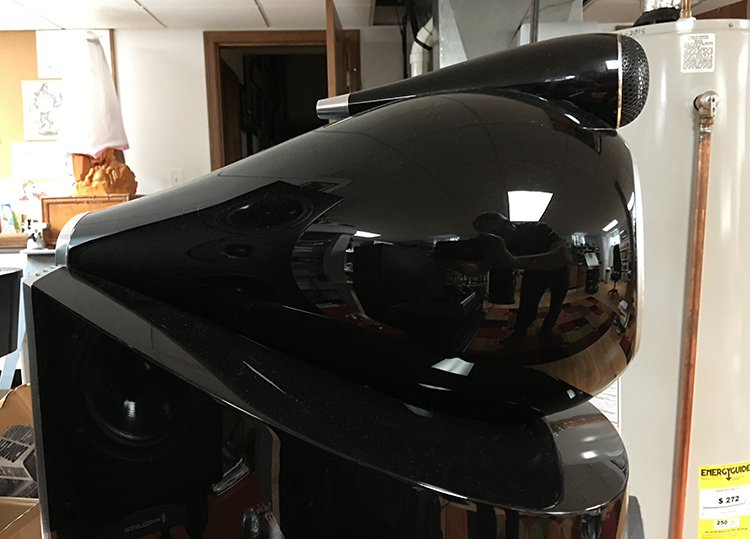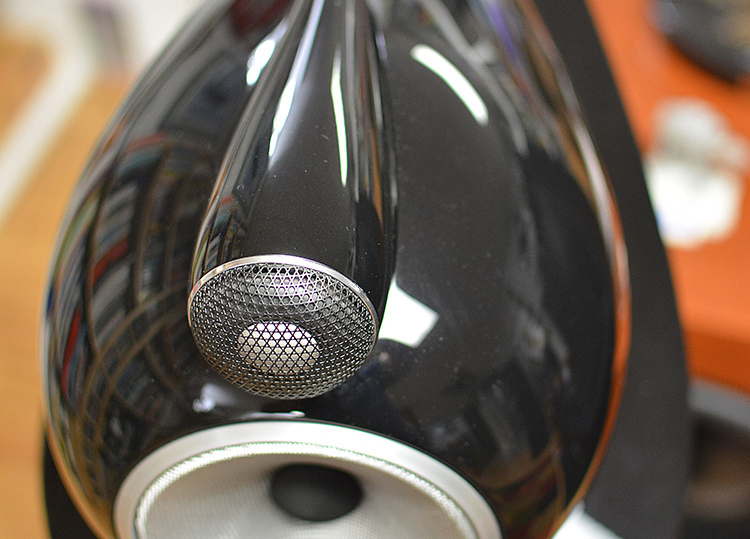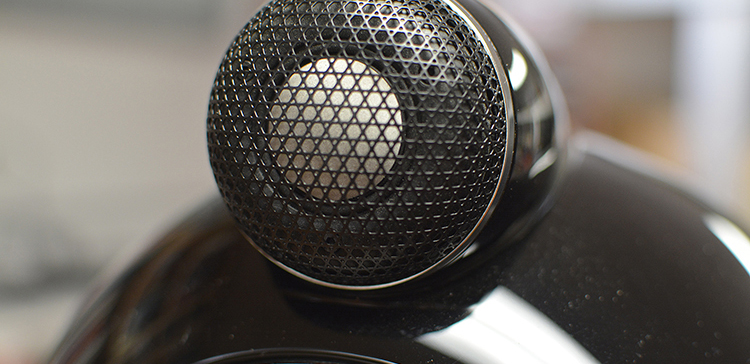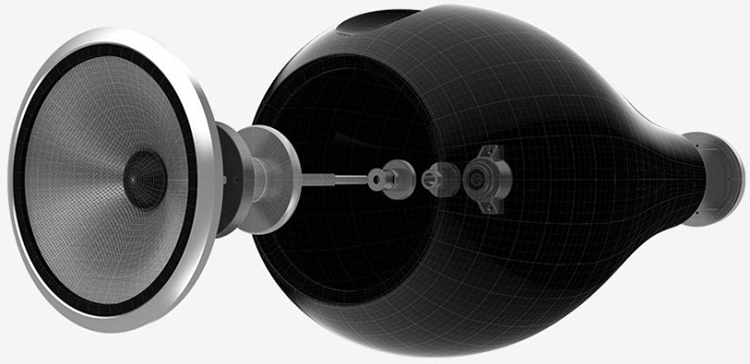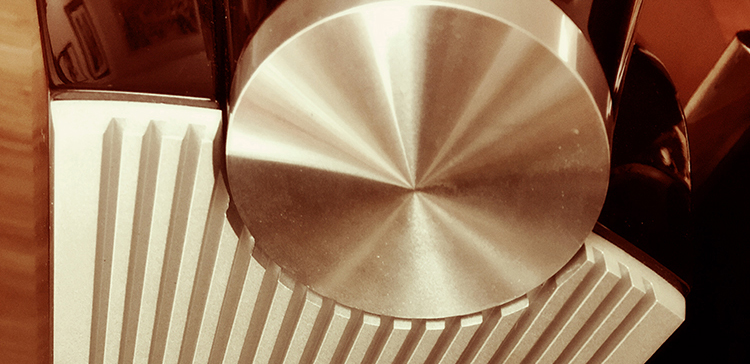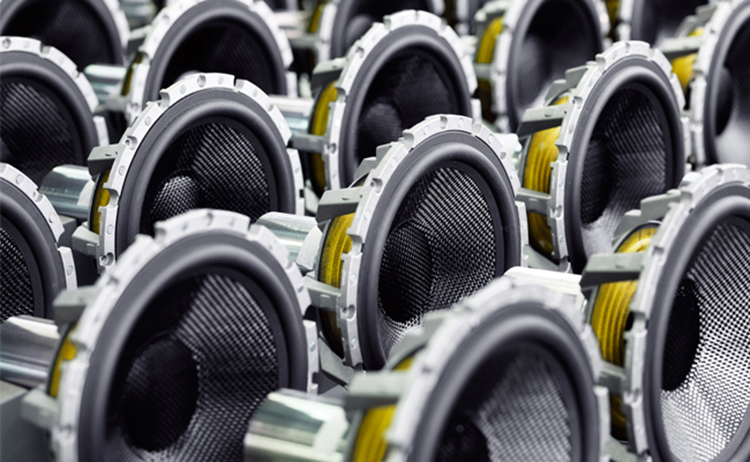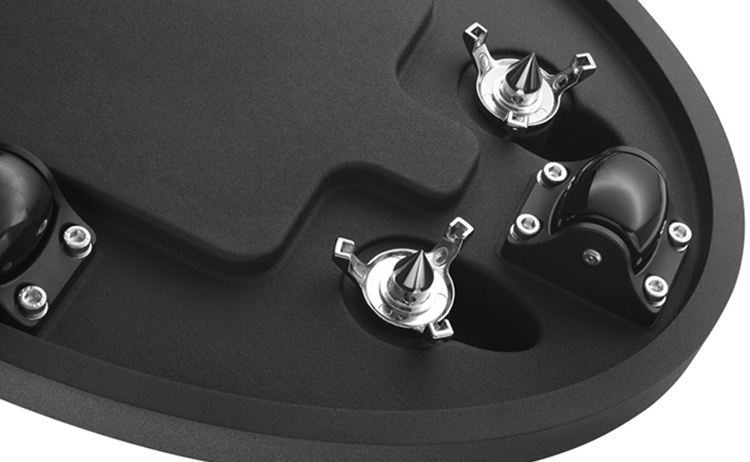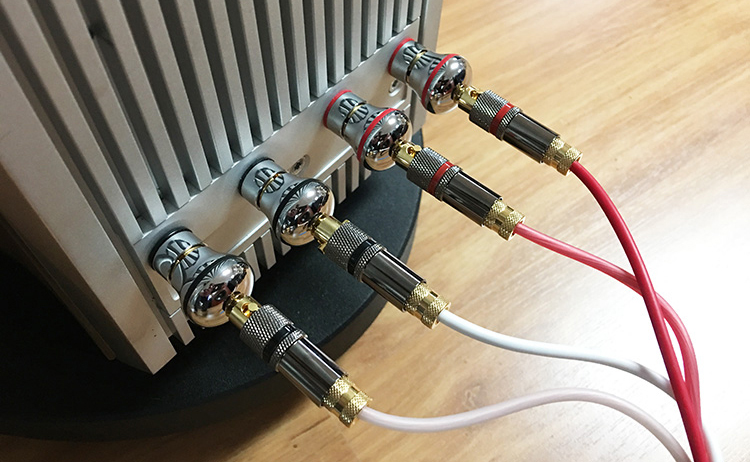Beginning with the art-deco inspired enclosure styling that is legitimately purposeful, to the technical and materials innovation that was born from years of development and research, the B&W 803 D3s project sound like a scrupulously clean beam of light that is unwaveringly revealing. Devoid of any noticeable distortion, these are certainly some of the cleanest sounding Hi-Fi speakers that I have ever experienced in my home.
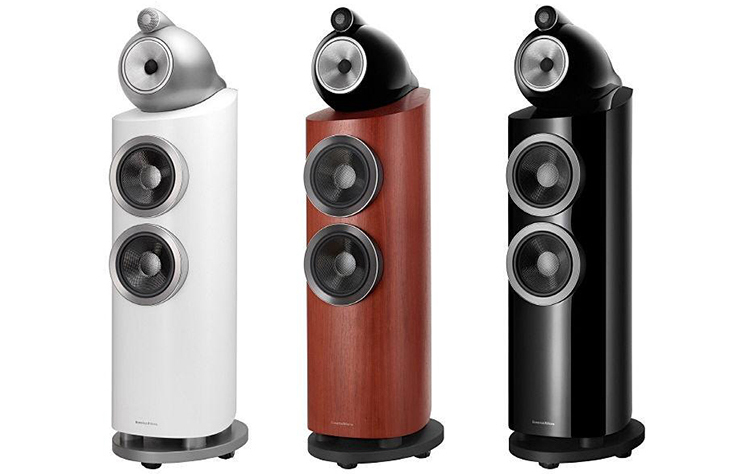
B&W 803 D3 Floor Standing Loudspeaker
- Diamond tweeter is not just hype. It has an exceptionally clean and natural sound.
- The midrange performance is outstanding in its transparency.
- Bass extension is linear and sounds natural without becoming exaggerated.
- The design aesthetic is gorgeous.
- Outstanding build quality with rigid structural integrity.
- Bi-wire and Bi-amp capable.
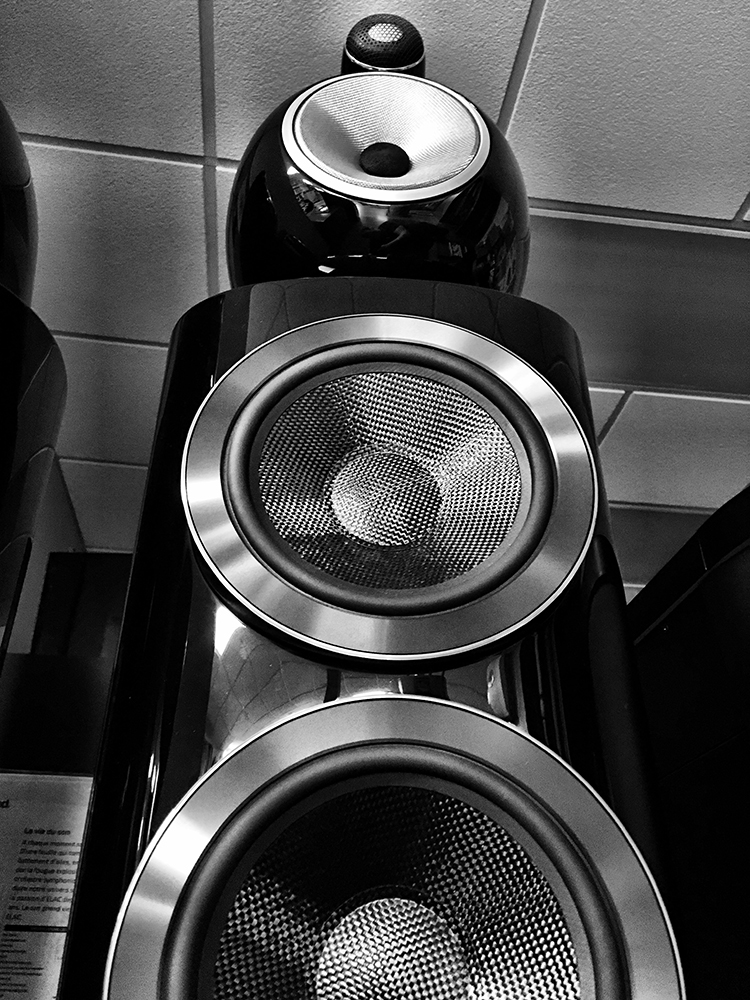
Bowers & Wilkins is a name that anyone who cares about audio, even on the most basic level, should instantly recognize. As one of the most storied names in British audio, they have pioneered several advancements in speaker design with many of their products finding homes with discerning audiophiles and recording studios alike. Probably the most iconic of B&W’s speakers would certainly be the 800 series. Originally launched in 1979, the flagship 801 model has garnered attention as the reference speakers of choice for such recording studios as Abby Road and Skywalker Sound.
Design:
3-way Floor-Standing Loudspeaker
Low Frequency Transducer:
Dual 7-inch “Aerofoil” cone bass drivers
Midrange Frequency Transducer:
Single 5-inch “Continuum” cone FST driver
High Frequency Transducer:
Single 1-inch Diamond Impregnated dome tweeter
Recommended Amplifier Power:
50 – 500 Watts RMS into 8 Ohms
Frequency Response (Manufacturer):
19 Hz – 28 kHz +/- 3dB
Sensitivity:
90 dB (2.83V @ 1M)
Nominal Impedance:
8 Ohm
Enclosure Type:
Bass-Reflex via Bottom Firing Port
Inputs:
Set of Four Binding Posts, Bi-Wire and Bi-Amp Capable
Dimensions:
45.7” H x 13.1” W x 19.6” D
Weight:
144 pounds each
Finish:
Gloss Black, Satin White and Rosenut Woodgrain Veneer
MSRP:
$17000.00 (pair)
Company:
SECRETS Tags:
B&W, 803, Diamond, Floor Standing Loudspeakers, Turbine, Continuum, B&W Reviews 2017
Last year B&W introduced a top-to-bottom redesign of the entire 800 series. It was the culmination of a multi-year development program that left no stone unturned in looking for ways to improve every facet of the lineup’s performance. It’s said that, with the exception of the diamond tweeter, each speaker in the 800 series is completely new and different from what came before. The prime focus of our interest in the 800 series is specifically the B&W 803 D3 floor-stander. It is the third from the top of the line in the series and it has to be one of the most striking looking speakers that I have come across.
When comparing the previous generation 803 to this new one, you could be forgiven for thinking that you were looking at a completely different speaker. The 7-year long gestation period of renewed 800 series has seen almost every component undergo a radical design and technical change.
The overall 800 series design language has evolved a bit over the years from the original boxy B&W 801 speaker in 1979 through to the sleeker “Nautilus” era models. The new and decidedly Art Deco design theme is truly a stand out, with the teardrop shape to the midrange driver housing and the industrial aluminum spine running up the back of each speaker. They seem more like sculptural art objects than practical furniture or entertainment items. And speaking of aluminum, that material is used extensively throughout the 803 D3’s revised structure. The aforementioned teardrop or “Turbine” head, as B&W terms it, is completely made of aluminum with additional aluminum ribbing inside creating a significantly more inert housing for the new midrange driver. The external diamond tweeter housing is milled from a single aluminum billet and it acts as a giant heat sink for the tweeter’s motor structure. The internal construction and bracing benefit from a move to a thicker birch plywood material rather than the original MDF that was used.
While the diamond tweeter remains, the trademark yellow Kevlar midrange drivers from previous B&W speakers are gone, replaced by a newly developed composite material called “Continuum.” The new material is said to provide a more open and neutral presentation with lower distortion characteristics across its operating range. The bass drivers have also been redesigned to deliver better low frequency extension and control. Dubbed “Aerofoil,” the new bass driver cones sport a new geometry that features a foam core sandwiched between carbon fiber skins. This creates a stiffer material and results in a better bass response with lower overall distortion.
The speaker body itself is mounted onto a metal plinth with about a 1.5-inch gap between the bottom firing tuned port and the top of the plinth. Underneath the plinth B&W thoughtfully provides a set of 4 wheels that allow the (144 lbs each) 803 D3 to be easily moved into position. Once settled, a set of included floor spikes and rubber feet can be installed and the wheels can be retracted with the use of an Allen wrench. I’ve never come across a pair of speakers equipped with its own “landing gear.” It is a very slick arrangement.
Secrets Sponsor
The speaker terminals consist of 4 smooth chrome knobs that are more reminiscent of fine furniture pulls than binding posts. They easily allow the use of spade lugs, banana plugs or heavy gauge bare wire and provide for bi-amping and bi-wiring.
For this review, the connected components consisted of: an OPPO BDP-105 Universal Disc Player, a Technics SL1200 Mk 6 turntable with a KAB fluid dampened tonearm mod and a Shure M97xE phono cartridge, a Parasound “Zphono” phono preamp, two Class D Audio SDS-470C Power amplifiers (300 watts @ 8 ohm, 600 watts @ 4 ohm) and a Panamax M5500 power conditioner. Speaker wire and interconnect cable by Blue Jeans Cable.
I settled on a positioning that had the speakers placed about 8 feet apart, toed in approximately 15 degrees, and set well into the room. The main listening position was about 9 feet away. Line-of-sight from the tweeters converged at a point approximately 1 foot behind my head. This allowed for the best overall imaging while permitting the speakers’ bass response to couple well with the room.
Let me start off by saying that, my wife loves the way these speakers look. Let that sentiment sink in for a moment. If my spouse is anything like some of yours, positive comments on how a piece of audio equipment sounds are few and far between. They do happen on occasion, but it’s usually as a casual mention or a comment in passing. When it comes to her making an agreeable mention of a review item’s appearance, well that is rarer still. It’s an event on par with finding hen’s teeth, or witnessing the passing of Halley’s Comet. In a strange turn of events, my wife was genuinely smitten with B&W 803 D3s aesthetic graces. The Art Deco design cues are strong and elegant. The lines of the “Turbine” midrange head and the tweeter enclosure are reminiscent of sleek and clean airplane, automotive and locomotive designs of the 1920s and 30s. The aluminum spine that anchors the full back of the speakers screams Empire State or Chrysler building. They looked particularly handsome, and received many compliments, when they took up residence in my home theater for a few weeks.
Secrets Sponsor
Before this encounter, I had only heard B&W 800 series speakers at audio shows. These were all for brief stints and in nowhere near what could pass for ideal conditions. Otherwise, I knew them strictly by reputation alone. For better or worse, this allowed me to have no pre-established notions of how they might or should sound. And having just come off reviewing the JBL 4367s, that speaker’s sonic signature was still fresh in my mind. From the first few minutes of playing familiar music on the B&W 803 D3, I knew that these were a completely different animal from the JBLs. A good month of listening later simply reinforced the obvious. The JBLs are a finely crafted “survival knife.” Dependably sharp, comfortable to use and adaptable to a variety of situations. The B&Ws are akin to a surgical scalpel. They are precision instruments with a midrange clarity unlike anything else I have experienced. The Diamond tweeter distinguishes itself as well, having a vast reserve of detail in its presentation along with an unexpected ease to its sound. Mated together, vocals become a living, writhing mass that possesses a genuine pulse. Fingers that run across any stringed instruments reveal an amazing level of detail. Cymbals, horns and harmonica sound clean and natural without anything that makes you grit your teeth nor want for some extra sizzle.
Bass extension is deep and tight. They are rated to reach 19 Hz +/- 3 dB and while the don’t quite reach that in this room, they do get down to the mid-20’s with a sense of authority. The B&Ws don’t seem to take advantage of room gain as much as the JBLs did so they don’t sound quite as punchy in the 40 -50 Hz range, but the bass response is very linear and natural sounding for their size. Lower register piano notes have decent weight and power and you will feel kick drum when it plays. The B&W 803 D3s also excel at throwing up a big sound stage, both in perceived width and depth. Off axis listening sounded very good, with the sound image staying very consistent and stable until I moved very wide afield.
It is because this speaker is so revealing that brings about the one shortcoming that it may have for prospective buyers. They can be quite ruthless and will show little mercy in disseminating all the gems from the turkeys in your audio collection. If it’s on the disk, LP or file, the B&Ws will serve it up and any production deficiencies will be staring at you plain as day. No quarter will be given. But, when you feed the 803 D3s a diet of the best recordings you have, you really do get something akin to magic! It’s that “alive” quality that remains elusive in many a speaker design, including some shamelessly expensive ones.
Being an 8 Ohm rated speaker and relatively efficient at 90 dB, the B&W 803 D3 were unexpectedly very easy to drive. When I had them in my home theater, the Anthem MRX 1120 receiver had absolutely no issues driving them to fairly loud levels without straining. If anything, the B&Ws may have annoyingly accentuated the shortcomings of the rest of my theater speakers!
Here are a few subjective impressions with some various musical material:

Indonesian child prodigy Joey Alexander impresses with this debut album, showing a command of the piano that I could not fathom an 11-year-old to ever possess. All the compositions are improvised standards with either trio or quartet playing.
Comprised of piano, bass and drums with occasionally trumpet, the CD is well recorded and produced and the B&W 803 D3s really let it shine. Alexander’s piano takes up the breadth of the space between the speakers on his solo interpretation of “Round Midnight.” With the lower notes set to the left channel and the higher notes panned to the right, listening to and tracing the keys as they move back and forth with his playing is an enjoyable experience with these speakers. There is just such a clean, clear ring and decay to the middle and upper piano notes that it just makes you shiver a little. The lower registers are also reproduced with decent heft and authority, sounding very tight throughout the solo.
On his take of Dizzy Gillespie’s “Tour De Force,” Alexander is joined by the rest of the quartet and the B&Ws project the entire performance cohesively while still allowing me to pick out the nuances of each players work. The trumpet stands out on this track having a delightful crispness to its sound without getting overly harsh or ragged sounding. The drums have a nice body to their sound; the sweeps of the brushes over the skins sounding nice and detailed. The riding cymbal had just the right sheen and shimmer to it and the bass line, while farther in the background, was easily discernable and sounded tight. Top to bottom the 803 D3 seemed to handle small ensemble jazz with a deft and even hand. Alexander’s own composition, titled “Ma Blues,” is a perfect example where piano, drums and bass each get a chance to stretch out and chase each other around. The B&W 803 D3s paint an exceptional sonic picture here. And the image doesn’t fade at all when you move, even well, out of the sweet spot. These speakers will fill a room with music and it will sound good from a variety of locations.
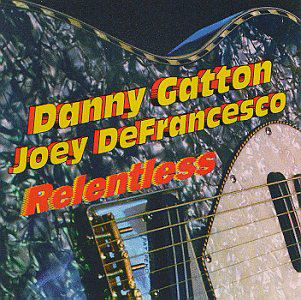
The late, great guitarist Danny Gatton and renowned keyboard player Joey De Francesco teamed up to record this rather smoking “jazz-ish” instrumental CD. The track “Broadway” quickly shows how these two respective virtuosos effectively push each other in their performances.
DeFrancesco’s Hammond B-3 organ is placed squarely in the center of the image, the notes from the B-3 having plenty of body and just the right amount of decay to them. Gatton’s Telecaster guitar starts on the left and moves to the center for soloing, and it has the right amount of bite and ring to the strings that you would expect with that particular guitar model. Standup bass playing by veteran jazz bassist John Previti was potent, with a good level of string detail coming through. “Gearheads” is like a country-infused, runaway freight train of a song barreling through the back-county. The B&W’s make Gatton’s guitar sound like it’s madly cackling at a ridiculously frenzied pace. It sounds properly ragged and edgy being chased around by the equally hectic and funky organ playing. A Hammond B-3 can have a fluid sound that I liken to running water, but this my friends was a torrent! Not thin sounding at all but, again, with the 803 D3s supplying plenty of body to the sound. The drums and bass on this track are particularly good, both hitting hard and deep with plenty of attack. They provide an unrelenting motive force to the song that just makes your foot tap almost reflexively. The track “Big Mo” slows and relaxes things considerably. The B&W’s take the bass and organ synergy and throw a big, wide spread of an image. Gatton’s guitar just sort of deftly dances across this stage with his piquant picking style, always remaining sharp, crisp and edgy but never veering to the abrasive.

Being a long time Leo Kottke fan, this CD strikes me as one of the odd-ducks in his discography. Focusing more on Kottke’s unconventional songwriting than his fingerpicking fireworks, it’s weirdly obtuse and that’s probably why I like it!
On the title track “Great Big Boy,” Kottke’s dry yet expressive baritone floats clear as day and is pegged, dead center, between the 803 D3s. The Continuum midrange driver wrings out an exceptional amount of detail from his voice, his age and experience being clearly communicated here. And the acoustic guitar playing, while not the star of the track, still has an impressive amount of string detail with the sounds of his fingers clearly heard moving over them with finesse. The new midrange crosses over cleanly to the diamond tweeter as evidenced by the ghostly flute solo that comes in at a couple of spots in this track. Plenty of drawing of breath could be heard at the instrument and the resultant notes smoothly flowed from upper midrange to the tweeter and back without sonic issue.
On the song “Driver,” the bass drum that punctuates the track at regular intervals is deep sounding and impactful through the 803 D3s. It provides a sturdy floor for the layers of acoustic guitar that sounded both detailed and atmospheric at the same time. Some of the lower guitar notes stand out with ample weight to them as well. Along with some synthesized ambience, it makes for a somewhat haunting song, yet interspersed throughout there are shimmers of triangles, chimes and maracas that come through crisply on that diamond tweeter. This song can sound bloated and slow on lesser speakers, but on the B&Ws it sounds lighter while still retaining the suitable moodiness. “Pepe Hush,” an odd song about a dog that won’t stop barking, has a repeating, syncopated rhythm that brings to mind a kind of demented wind-up toy. Kottke’s trademark picking style, along with the various types of background percussion, and the deep repeating bass drum make for a complex sounding background that the B&W’s seem to have no trouble in sorting out and keeping crystal clear for the listener. Contrasting to Kottke’s sotto vocals, Margo Timmins (from The Cowboy Junkies) supplies chorus vocals that 803 D3s render with a luminous glow that just fills the space between the towers. Most unconventional, but fun to listen to on these speakers!
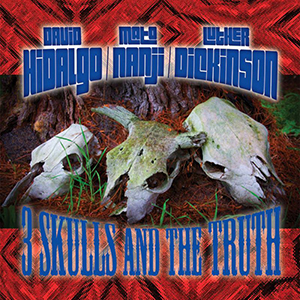
I was in a heavy guitar mood while these speakers were with me and this disk is just the ticket for something like that. With three strong blues/rock players, each having distinctive playing styles and very distinct voices, this CD made for an interesting piece of test material.
On the first song, “Have My Way With You,” each of the three gets to sing a verse with Luther Dickinson, sounding very much like Peter Wolf from the J. Geils Band, starting out. Mato Nanji comes in for the second verse, channeling a bit of Billy Gibbons from ZZ Top and David Hidalgo comes in for the third verse sounding….very much like himself when he sings for Los Lobos. What makes this track novel is that it really allows the B&W’s midrange clarity to illuminate the different characteristics in three male vocalists singing simple three-bar blues. These guys, singing in the same vocal range, might not stand out quite so much from each other on other speakers. Played back on anything less revealing and you may not even notice or give it a second thought. You obviously will know it’s three different guys singing but the detail differences won’t stand out. But on the 803 D3s, it is abundantly clear just how different these three performers sound when they sing this material. I’ll say it again, these B&Ws are very good at mining everything that’s there in a recording. The 7-odd years of development time definitely shows when uncovering nuances like this. And as for the rest of the album, permit me to say that these B&W’s will handle shredding guitar solos, hard drumming and thumping basslines with aplomb. Many rock or blues albums come off sounding flat or thin with speakers like these, but not so here. This is big music that sounds punchy and crunchy! Other stand out tracks are “I’m A Fool”, “Make It Right” and “Natural Comb.”
This is a good looking and equally good sounding pair of speakers overall. They are also impeccably put together. If I were to want for anything here, it would be for some additional bass punch in some cases. I don’t think it’s bass-shy by most people’s expectations but sometimes, I was wanting just a little extra “oomph.” Of course, if you are in the market for speakers in this price range, you could simply splurge for the B&W 802s and that would probably cover your additional bass desires. Ah….decisions, decisions!
Benchmark audio tests of the B&W 803 D3 Floorstanding Loudspeaker were conducted using a calibrated Earthworks M30 microphone. The source device was a LYNX Two professional PC sound card using test signals created by SpectraPLUS audio measurement software. Measurements for on and off axis frequency response were taken at a distance of 1 meter from the speaker while distortion measurements were taken at 1-foot distance from the appropriate driver. Average in-room response measurements were taken using Room EQ Wizard software and a calibrated Umik-1 USB microphone.

The B&W 803 D3s on-axis frequency response shows generally good behavior from 500 Hz on up. There seems to be a gentle rise in the response centered at 10kHz with a slow roll off in the high end beginning at 15 kHz. What is striking is how closely the 30 degree Off-Axis measurement tracks the On-Axis result, particularly above 10 kHz. This indicates that the B&W’s will sound very much the same if you are not sitting in, or frankly close to, the sweet spot. Everything below 300 Hz is governed by room modes and is less of a concern at this point with this measurement.
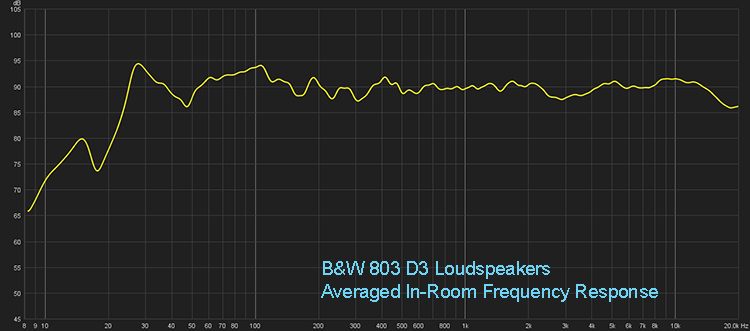
This graph shows an averaged in room response that was culled from 14 measurements taken at various points around the main listening area. Unlike the on-axis measurement, this tries to give a better indication of what the speaker’s legitimate response is. There is a mild dip in treble from about 2.5 kHz to 4kHz and the upper end experiences a gradual 4 dB roll off from 15kHz to 20kHz, the latter trait being not unusual. The entire midrange is flat and well behaved. The bass region is a little unusual with a noticeable dip at 48 Hz, a peak at about 27 Hz and then a steep roll off in the bass after that.
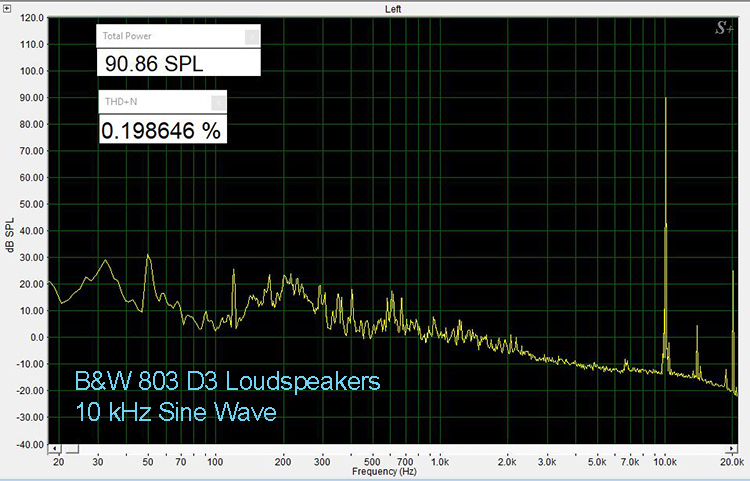
Distortion measurements for speakers are typically done at a 90 dB reference point.
This particular graph shows a distortion level, at 10 kHz, of only 0.198646% at 90 db. Essentially inaudible.
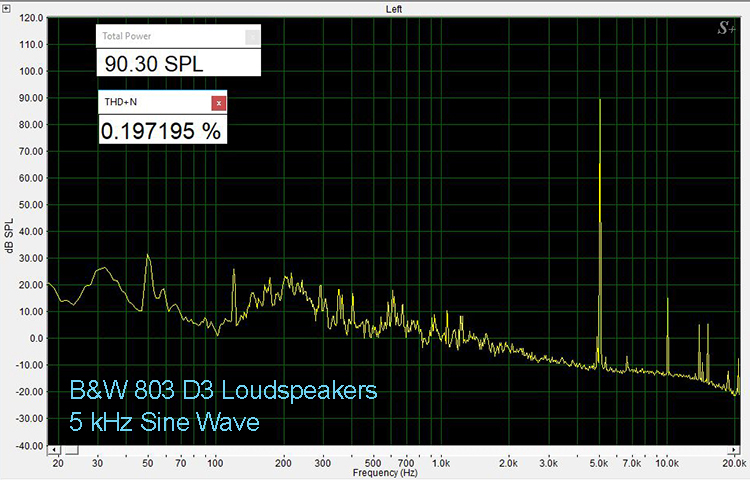
At 5 kHz the distortion level at 90 dB is almost identical, at 0.197195%. Again, inaudible.
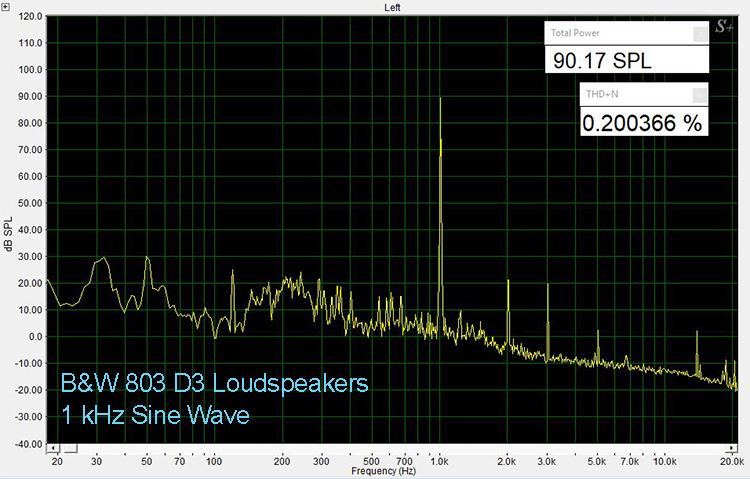
At 1 kHz, the distortion level at 90 dB rises imperceptibly to 0.200366%.
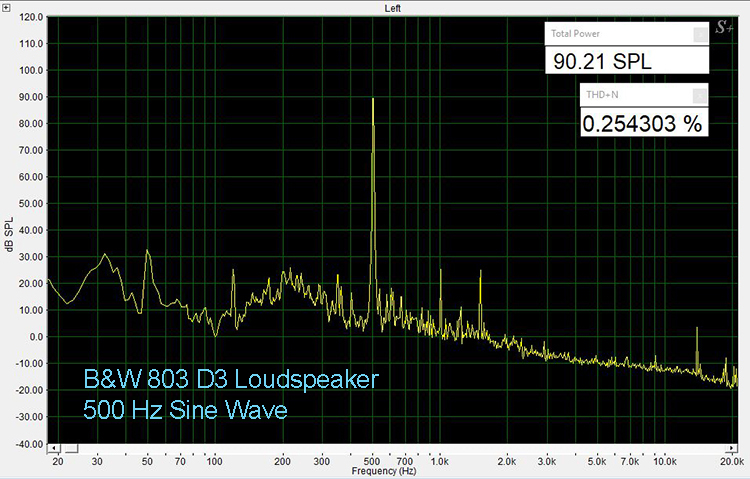
At 500 Hz, the distortion level at 90 dB slightly increases to 0.254303%. For fear of sounding like a broken record, you will not hear this.
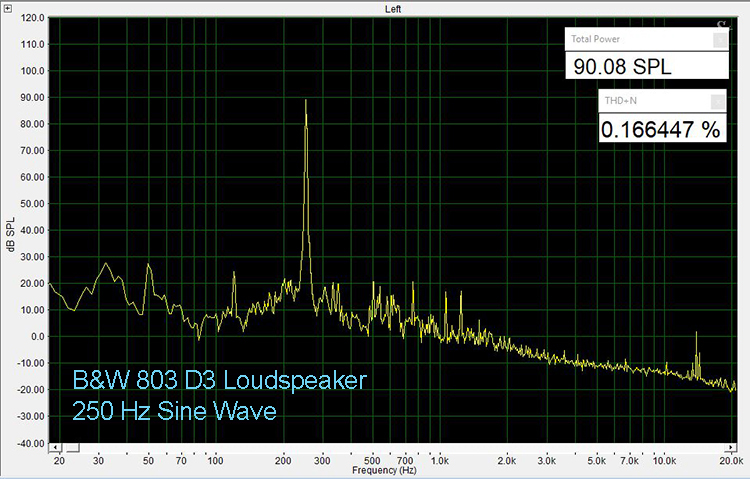
At 250 Hz, the distortion level at 90 dB drops to 0.166447%.
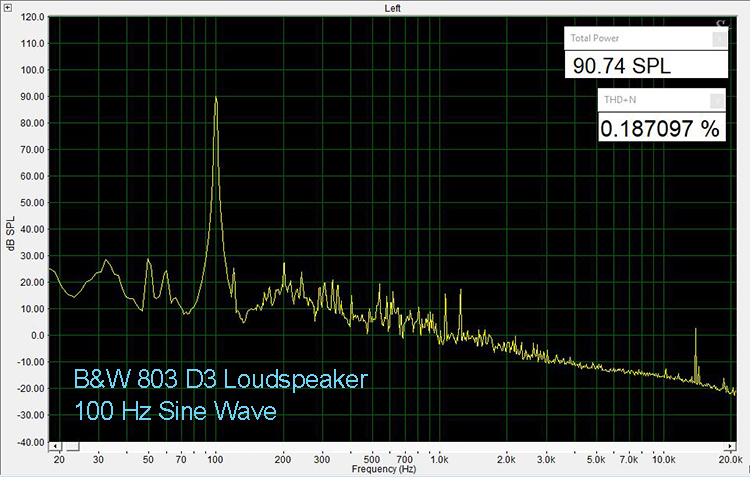
At 100 Hz, the distortion level at 90 dB remains consistently inaudible, reading 0.187097%.
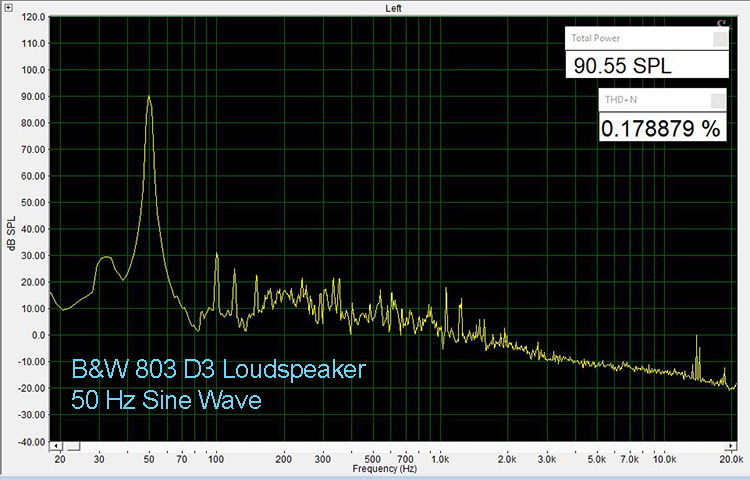
At 50 Hz, the distortion level at 90 dB stays consistent at 0.178879%. Remember that distortion levels in speakers are commonly considered to be audible at levels of 10% and above.
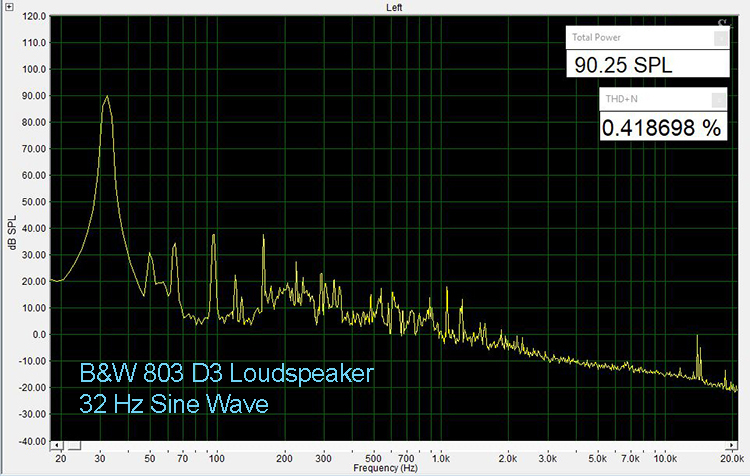
At 32 Hz, the distortion level at 90 dB rises slightly to 0.418698%. The distortion level across the audible band has yet to crack 0.5%. This is outstanding!
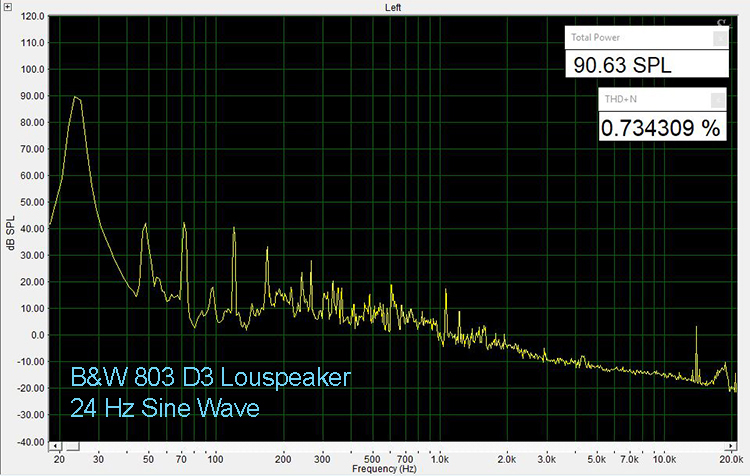
Measured at the driver, the distortion level for 24 Hz at 90 dB is 0.734309%. It is an impressive feat that the B&W 803 D3 loudspeakers maintain such a uniformly inaudible level of distortion across its operating range. Well done!
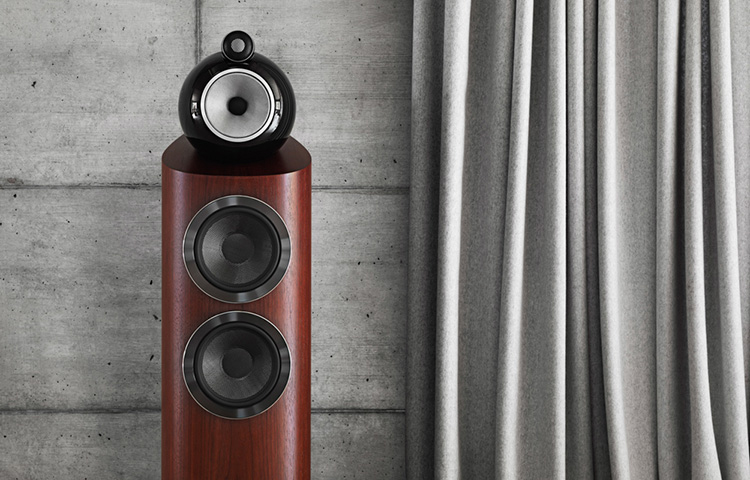
For those searching for something that looks as special as it sounds, THE B&W 803 D3 are an obvious choice.
- Gorgeous design.
- Exceptional midrange clarity with natural sounding treble and bass.
- Very wide dispersion. Sounds as good when listening off-axis as when listening on-axis.
- Superb build quality.
- Maybe a little punchier bass response. But you could always splurge for the next size up!
The B&W 803 D3 is an impressive speaker in many respects. Aesthetically, it is a design feast for the eyes while sonically, it is exceedingly pleasing to the ears as well. The development time that B&W spent redesigning and refining every aspect of the 800 series has resulted in a speaker with an exceptional level of clarity, wide dispersion and especially low levels of distortion. The midrange performance being particularly noteworthy, as well recorded vocals tended to shine with the 803 D3s. It is a revealing speaker and, in many cases, will not flatter sub-optimal recordings. It is easy to see why the larger models of the line are liked by recording studios. The lack of overall distortion, I think, is one of the key reasons these speakers sound so good. If you are seriously looking at loudspeakers of this price category and you appreciate a more avant-garde kind of aesthetic, then the B&W 803 D3s certainly deserve your time and ear. It could prove to be a very rewarding experience indeed!


